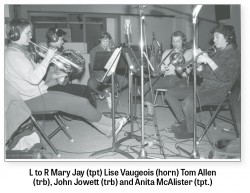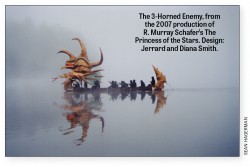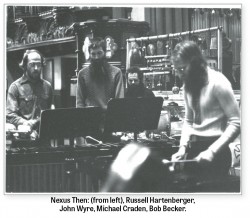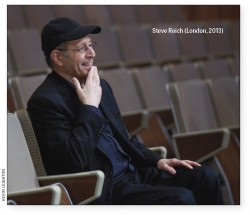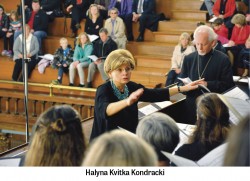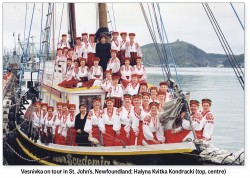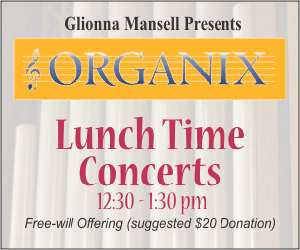Alison Mackay’s Coffee House Creation
![]()
For the full interivew, listen via the play button below or right click here and "Save As":
We are approaching the half-hour point in my taped conversation with Alison Mackay, Tafelmusik’s longtime violone/contrabass player and concert curator extraordinaire, and are finally getting round to the ostensible reason for having this conversation at this time – Tafelmusik’s upcoming presentation titled “Tales of Two Cities: The Leipzig-Damascus Coffee House.” As always with Mackay’s projects, it’s an immensely engaging premise – taking two cities, thousands of miles and worlds apart – and viewing them through the musical lens of the same moment of historical and cultural time.
“Let me tell you a fun thing before we get into it,” I say. “On May 21st, which is the middle of your run at Koerner Hall, Zimmermann’s Coffee House in Leipzig will be featured on stage in your show, and the same evening in the Peter Hall of the Moravian College in Bethlehem, Pennsylvania, “Zimmerman’s Coffee House” will be the title of the last evening concert of their 109th festival. And if you trace that college back to its schoolhouse origins, it goes back to 1745, which is only 20 years after Bach arrived in Leipzig!”
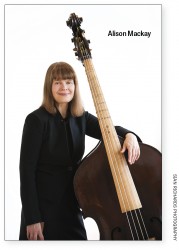
“Oh that’s wonderful,” she says, delightedly. “We should get in touch with them and see what we could do together.”
It’s a typical response from Mackay, whose relish for the juxtapositions, coincidences and synchronicities that offer opportunities to see old things anew, has become her curatorial trademark.
Memory Lane: We have just finished a rambled down memory lane, starting with the first of her Tafelmusik projects I can remember, “The Four Seasons: Cycle of the Sun,” back in 2004. That project took 1725, the year Vivaldi’s Le quattro stagioni was published, and made that year the departure point for an investigation of other musics being made in the world in the same year – an exploration that encompassed Chinese pipa, Indian veena and Inuit throat singing.
One can see the same bird’s eye imagination at work in her “Galileo Project.” “It was in 2009, she says, “part of the International Year of Astronomy, because 1609 was the year Galileo first turned his telescope on the night sky. There were to be international celebrations of that event and we were actually approached by the Canadian committee that was planning events surrounding the year, to curate an event that would link astronomy and art.”
“Cutting across strata of geography and time is something you are good at,” I say.
“For me the seed of these projects is always in the music,” she says. “These events and performances are always concerts and there’s always a concert’s worth of music in them. And it’s very much about celebrating having a chance to perform the very best music in our repertoire. I hate having to include anything that’s only there because it matches the subject. I love to include profound, wonderful music – the best of our repertoire but giving the chance, just once in a while, to see it in a wider historical and cultural context. It shines a new light on the music. So it’s not that I think that audiences now have shorter attention spans or anything like that, or that they need visuals or bells and whistles. I still very much believe in purely musical concerts.”
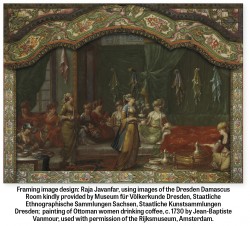 These amplified concert forms are just as much for the musicians benefit as for the audience’s, she points out, using Vivaldi as an example. “Something like The Four Seasons is something our audience likes to hear pretty regularly. It’s a pretty beloved piece. It’s become a little bit cliched, because we hear it so much in elevators and things like that, but our audience loves to hear it, we love to play it, it’s a showpiece for our violins…but it’s very wonderful to bring some new dimension to it, a new kind of excitement for us.
These amplified concert forms are just as much for the musicians benefit as for the audience’s, she points out, using Vivaldi as an example. “Something like The Four Seasons is something our audience likes to hear pretty regularly. It’s a pretty beloved piece. It’s become a little bit cliched, because we hear it so much in elevators and things like that, but our audience loves to hear it, we love to play it, it’s a showpiece for our violins…but it’s very wonderful to bring some new dimension to it, a new kind of excitement for us.
“To give another example, a lot of the repertoire we play contains overtures and dance suites from operas, Lully for instance. And many opera composers in the 17th and 18th centuries were inspired by Ovid’s Metamorphoses. Brief stories, a lot of them with a central moment of incredible dramatic power and transformation…when you put that same music in the context of the story that informs each of its movements (Marin Marais’ Alcione, for example) it makes it incredibly profound for the performers and the audience, so not only does it add a cultural dimension to the music but it also adds a new layer of emotional context.” It’s an emotional “informing” of the piece that remains for the musicians after that, even when the piece is performed without the story added. “Somehow I think the emotion of the way we perform with each other, especially when we are playing from memory the way we do in these projects, communicates a new excitement and emotion to the audience. Of all the things that have influenced performing life at Tafelmusik, this – the grounding and heightening and enriching of context – has meant so much.”
Perhaps her most ambitious project to date in terms of multi-disciplinary scope and scale was “House of Dreams.” It was a journey to five houses in five European cities, all of them still standing, which for one reason or another, at some time in their history housed very important private collections of paintings. “In London, Venice, Delft, Leipzig and Paris,” she explains. “And in the rooms where the paintings were hanging, there were known to be performances of music, often by the most important composers in those cities.”
The buildings, in their present incarnations encompass a range of uses. “Two are small museums, one is a rather down-at-heel palazzo on the Grand Canal in Venice, one is a pancake restaurant in Delft, on the main square which has changed very little since the 17th century.” The Delft house, she explains, was owned by a very poor bookbinder, married to a young woman who died tragically, soon after. When his death followed, a few years later, he was found to have had, “hanging in his little tiny house, 23 of the 36 known Vermeers.”
Today, she informs me, the pancake restaurant prides itself more on the fact that Bill Clinton ate there, and has a letter from him to that effect on the wall. “We had to ask to remove it from the wall when we went to do our photography session there.”
The way the project worked was that over the course of about a year Tafelmusik formed relationships with the present owners for the purpose of photographing all the walls where the paintings had been. They then acquired high resolution images of all the paintings and were able to put the paintings back on the walls, and then put the music, live, back into the rooms with the paintings on the walls. “A bit like a guest in the house experiencing a Rembrandt on the wall and listening to Handel conduct his music at the same time.”
“House of Dreams” was also a memorized project; “Tale of Two Cities” will be their fourth. For Mackay, the fact, and feat of incorporating memorization into these projects has radically transformed, for the better the ensemble’s musicianship. She is aware of the toll it takes, but conscious of its immense rewards, for audience and performers alike.
“It’s a huge, huge undertaking for the orchestra and I cannot tell you how incredibly grateful I am at the number of hours of unpaid work that go into that…It’s been socially transforming…The music is so complex. I think that when you memorize something it frees you up physically. You present a more complete physicality. And the more that you do these projects – I think we have done the “Galileo Project” around the world around 75 times and “House of Dreams” in nearing 40, so they continue to grow and develop musically. We had these very nervous discussions at the start, none of us knew how it was going to work. Normally you’d say ‘okay, we are all going to start at bar 76.’ That was never an issue; someone would just start playing and everyone knew where to come in. You practise in a different way. It lifts the technical and it also lifts the ensemble.”
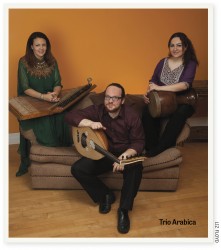 Leipzig-Damascus: So here we are, half an hour in, finally starting to talk about the current project, “Tales of Two Cities.” We have reached the Leipzig-Damascus Coffee House.
Leipzig-Damascus: So here we are, half an hour in, finally starting to talk about the current project, “Tales of Two Cities.” We have reached the Leipzig-Damascus Coffee House.
As always it’s finding the similarities in different places at the same moment in time that is her creative spark.
“It’s very interesting. They were both entrepôt cities, at the crossroads of ancient, often Roman, roads - ancient trade or caravan routes. Leipzig was a small city but it lay at the crossroads of the east-west road that went from Santiagio de Compostela right to Kiev and Moscow, and goods and ideas flowed gradually along that route. And then there was a north-south route that ran from Venice and Rome to the Baltic Sea. Those two roads crossed right in the middle of Leipzig and because of that the Holy Roman Emperors declared it a trade fair centre with tax incentives and a protected place, so it meant for centuries traders from all over Europe and as far away as London and Siberia and Constantinople converged in this little crossroad town of about 30,000 - the size of Toronto’s Annex.
“The city of Damascus was a much more ancient city - some people think it is the oldest continually inhabited city in the world, and it lay at the crossroads of routes from the Mediterranean, from Tyre and Sidon through Syria to Baghdad, through Iran to the Silk Road and the Far East. And the north-south route that went from Yemen up to Mecca and Medina, Damascus, Aleppo, Anatolia and finally Istambul.”
Damascus became the place where travellers on the pilgrims’ road to the hajj provisioned for the very dangerous journey. And they would come back to Damascus with coffee which was grown in Yemen, first known place of cultivation of what we know as the arabica coffee bean.
The parallels go on and on. Both cities at the axis of a trade route and a pilgrims’ road; both cities famous centres for scholarship and learning; Leipzig hugely important for book publishing and dissemination, poetry, literature, plays, philosophy; the same true of Damascus, renowned for science, theology, law, poetry and travel writers.
From there the stories start to actually intersect in extraordinary and tangible ways – an important family library of secular and religious 18th-century works of Damascene scribes being sold to the Prussian ambassador and finding its way to the University of Leipzig; the Ottoman ambassador to Louis XV bringing 10,000 pounds of coffee to France. And the emergence in both cities of lively coffee house cultures, Zimmermann’s in Leipzig being the one most notably associated with Bach and Telemann.
In the German city of Leipzig, Johann Sebastian Bach directed an ensemble which gave Friday-night concerts between the hours of eight and ten at Zimmerman’s Coffee houses on the Katharinenstrasse.
In the coffee houses of Damascus, singers and performers on the oud, kanun, ney, and daf played classical Arabic taqsims and muwashshahs, and used their instruments to accompany famous storytellers reciting from the rich tradition of adventure stories and Sufi tales found in Syrian manuscript sources.
The Leipzig-Damascus Coffee House of the show’s title promises to be resplendent visually, revolving around a set piece with a large imbedded projection screen which will evoke in turn two 18th-century interiors – a Damascus ajami room and a Saxon wood-panelled interior, prepared under the guidance and supervision of Dr. Anke Scharrahs, a conservator who specializes in the research and restoration of polychrome wooden surfaces and who is one of the most highly respected international experts on the conservation of Syrian-Ottoman interiors.
But true to Mackay’s credo, the music will be, as always, at the heart of things. Tafelmusik will perform, from memory, music plausibly connected with Zimmerman’s; Arabic music, appropriate to the Damascene coffee house,will be rendered by Trio Arabica, an ensemble consisting of Toronto-based, Egyptian-born, and Syrian-trained Maryem Tollar (narrator & vocalist), Naghmeh Farahmand (percussion) and Demetri Petsalakis (oud), with narration/context provided in English and in Arabic by both Tollar and by actor Alon Nashman, blending storytelling and documentary roles as required.
And naturally, at appropriate and carefully chosen moments, the work of the two ensembles will combine and intersect because such hard-earned coincidences have been in one respect or another the lifeblood of the magic she weaves for Tafelmusik. They are, in a way, the continuo of her imagination.
Mackay’s work is not overtly political, but one can detect a quiet satisfaction in her at the timing of this particular tale. In a time of geopolitical ferment when traffic on the road from Damascus to Leipzig appears to be going only in one direction, it does no harm, and may even do some good, to reflect on the extent to which, in terms of history and culture, this is is very much a two-way street.
David Perlman is the publisher of The WholeNote.


